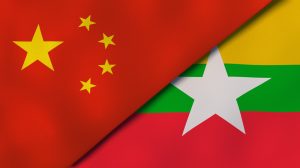China’s public security minister yesterday met with leading members of Myanmar’s military government to discuss the restoration of “peace and stability” along their shared border, as three resistance groups continued an armed offensive in the country’s northeast.
According to a report in today’s edition of the Global New Light of Myanmar, Wang Xiaohong, who is also a member of China’s State Council, met junta chief Senior Gen. Min Aung Hlaing in the capital Naypyidaw yesterday. According to the New Light’s stilted paraphrase, the two officials discussed the “attacks of MNDAA insurgents on security camps in the northeast region of Myanmar with attempts to deteriorate peace and stability in the region.”
There was a similar agenda to earlier meetings that Wang held with Immigration and Population Minister Myint Kyaing and Home Minister Yar Pyae. The first meeting addressed the question of “stability and peace” in the border regions, while the second discussed “peace and tranquility in border areas of the two countries” and cooperation on law enforcement and security.
It is hard to imagine that Wang’s visit is unrelated to the offensive that an alliance of ethnic rebel groups launched on October 27 against Myanmar’s military administration and its allies in the northern part of Shan State.
The attack is being carried out by the Three Brotherhood Alliance – a pact between the Arakan Army, the Myanmar National Democratic Alliance Army (the aforementioned MNDAA), and the Ta’ang National Liberation Army – and has been accompanied by attacks on junta positions by resistance groups in other regions of the country. According to informed estimates, the Alliance has as many as 20,000 armed personnel at its disposal.
The Alliance claimed yesterday that in the first five days of Operation 1027, as it has been dubbed, it had seized more than 70 Myanmar military outposts across northern Shan State, the Democratic Voice of Burma reported. In the process, it claims to have captured large amounts of weapons and ammunition, including two tanks manufactured in Ukraine. The Alliance reportedly now controls the towns of Chinshwehaw, on the Chinese border, and Hsenwi, which occupies the strategic crossroads of the highways leading from central Myanmar to the major border crossings with Chinshwehaw and Muse.
Fighting reportedly continues in Kunlong, Namkham, Nawnghkio, Mogok, and Lashio townships. While the Myanmar military has responded with air strikes, no major land counter-offensive has yet eventuated.
The renewed fighting has serious implications for Chinese interests in Myanmar, which center around the creation of a transport corridor connecting Yunnan province to the Bay of Bengal. Under the rubric of the China-Myanmar Economic Corridor (CMEC), a sub-pillar of the Belt and Road Initiative, Beijing has planned highway and rail links from China to Myanmar’s coast, as well as free trade zones and a deep-sea port at Kyaukphyu, in Rakhine State.
This corridor runs directly through the region affected by the current offensive. Indeed, the town of Chinshwehaw, now under MNDAA control, has been earmarked as the location of a future free trade zone, while resistance forces have succeeded in cutting the highway running from Lashio to the Chinese border – the country’s main artery of trade with China.
There is also a high likelihood that continued fighting will drive civilians across the Chinese border, as has happened during past outbreaks of conflict in the region. The U.N. Office for the Coordination of Humanitarian Affairs said that as of October 30, more than 6,200 people “have reportedly been newly displaced, seeking refuge in nearby forests or religious compounds within northern Shan.” It said that several hundred additional people have reportedly crossed the border into China in search of safety.
Shortly after the beginning of the offensive, China’s Foreign Ministry called for an immediate ceasefire. It also urged “the relevant parties to resolve differences peacefully through dialogue and consultation, avoid escalation of incidents, and take concrete and effective measures to ensure security and stability of the China-Myanmar border.”
While the outcome of the current offensive is hard to predict, how China chooses to react could have far-reaching consequences. The most immediate question is whether China will use its influence over the armed rebel groups of Shan State to bring about a ceasefire, in the interests of shoring up the junta’s control and allowing its CMEC projects to proceed. The ultimate aims and success of Operation 1027 remains unclear, but the current rapid changes in Shan State raise the more fundamental question of when Chinese policymakers might decide that the military administration is teetering and begin organizing for what comes next.
































